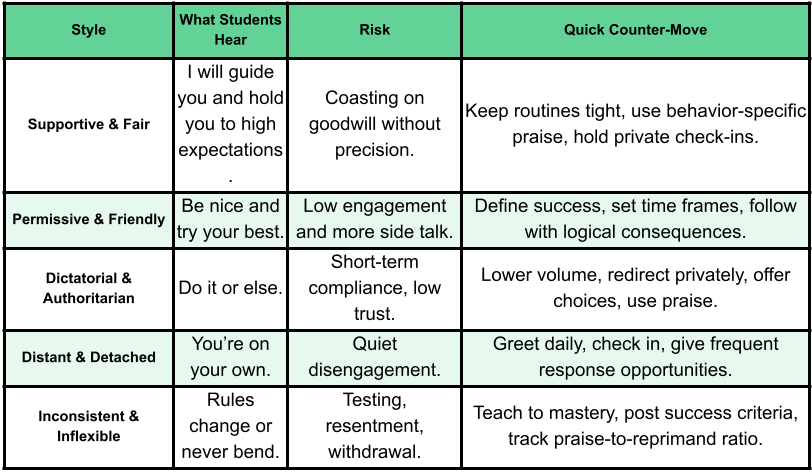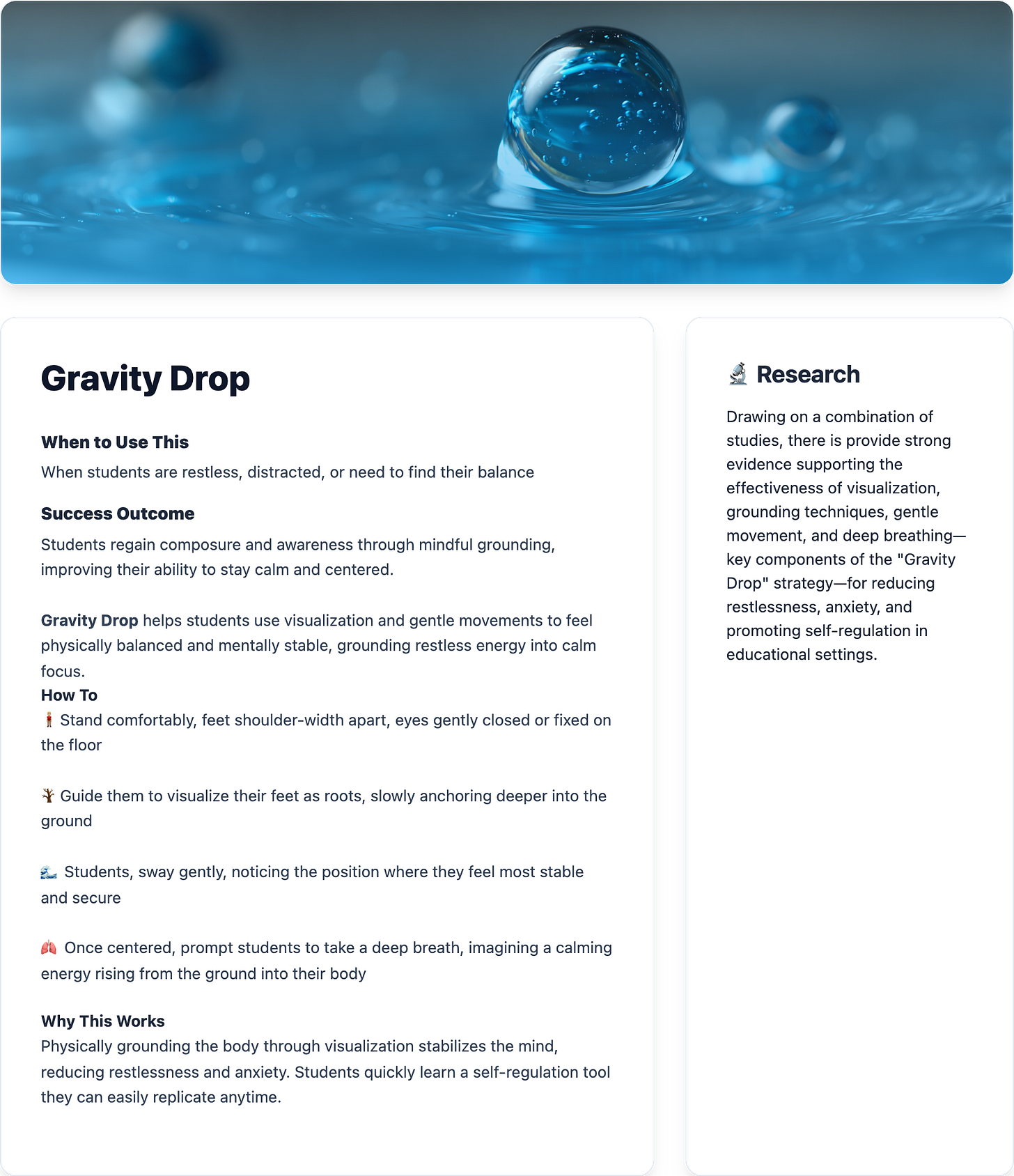✨Part 2: How Teacher–Student Relationships Define Your Classroom Management Style
Why connection, not control, is the real foundation of effective classroom management

Is your classroom orderly but lacking warmth? Are your students compliant but not engaged? Many teachers default to a management style that puts up walls between themselves and their students. But what if you could soften that approach and build strong relationships without losing control? This guide explores three common classroom management styles, explains their impact on students, and helps you identify your own style. It also offers insights for bridging the gap between your teaching approach and building deeper connections with your students.
Authoritarian
These teachers operate with a “my way or the highway” stance, remaining emotionally distant and unyielding. Praise is rare; correction is common.
The consequences of this style affect students both emotionally and academically.
The Emotional and Academic Toll
When teachers rely on strict control with little personal connection, students disengage and lose confidence in their abilities. Research shows this authoritarian style significantly undermines student well-being and emotional safety. Although the classroom may appear orderly, it lacks rapport. The stress of enforcing unbending control leads to teacher burnout. Students learn compliance rather than curiosity, and meaningful engagement declines.
You know this is your style if:
You are often in a power struggle with students.
Your primary feedback is corrective rather than encouraging.
You feel drained by the constant need to enforce rules.
The Fix
The solution is not more control; it is connection. Grounding routines like Gravity Drop (strategy below) can counter authoritarian tendencies by re-establishing a sense of safety and giving students a way to release stress.
Inside the Brain
In an authoritarian classroom, fear of making a mistake activates your amygdala, the brain's threat-detection center. This triggers a fight-or-flight response, which reduces the connections to your prefrontal cortex, the part of the brain that's essential for learning and problem-solving.
A 2024 study by Peng and Huang found that teachers’ authoritarian leadership negatively impacts students’ well-being. Their research, based on conservation of resources theory, showed that authoritarian teaching increases students’ emotional exhaustion, which in turn lowers their overall well-being. The study also found that students’ individual traits, such as narcissism, can moderate how strongly authoritarian behavior affects their emotional exhaustion and well-being (Peng & Huang, 2024).
Detached
This style is often characterized by a focus on content over connection. Teachers who lean into this approach may be pleasant and agreeable but are emotionally distant, viewing their role as a deliverer of information rather than a facilitator of relationships and a creator of community. Their knowledge of students rarely extends beyond academic performance and classroom behavior. Interactions are transactional, limited to a quick word about a grade or a rule
The Emotional and Academic Toll
The lack of personal recognition erodes students' trust and fosters a sense of insecurity. When a student's emotional needs are not met, their brain interprets this indifference as unsafe, activating stress circuits in the limbic system. This constant low-level stress can lead to disengagement because students don't feel seen or supported. As the drive for meaningful relationships weakens, so does the motivation for rigorous learning. While the classroom may be quiet, student participation and persistence are often low.
You know this is your style if:
You prioritize covering content over connecting with students.
Your feedback, whether oral or written, is typically to correct or redirect.
You know little about students’ lives outside of academics.
The room stays quiet, but participation and persistence are low.
The Fix
The solution isn't found in a new curriculum; it's in cultivating teacher presence. Simple, consistent actions like greeting students daily, using their names, and giving specific, growth-focused feedback help establish connection. A grounding routine like The Bright Stuff can counter detached tendencies and is detailed later in this article.
Inside the Brain:
When a teacher is emotionally detached, the brain's limbic system, the part that handles emotions and stress, interprets this lack of connection as a threat. This triggers a low-level stress response, making it hard to feel safe and pay attention. Your brain then diverts energy to managing this insecurity, which means less focus is available for learning and memory.
The Research Connection
A 2021 study in the journal Learning and Instruction by Väänänen et al. found that students who perceived a low level of teacher support reported a higher level of emotional disengagement from school. This research, based on a sample of middle and high school students, showed that a lack of emotional support from teachers contributed to feelings of alienation and a reduced sense of belonging, which are key predictors of academic disengagement. (Väänänen et al., 2021)
Inconsistent
When expectations shift or rules are enforced unevenly, students become insecure. This unpredictability makes the classroom feel unstable and fuels anxiety and resentment.
The Emotional and Academic Toll
The first casualty in an inconsistent classroom is trust. The lack of consistent rules and procedures leads to constant battles and easily escalated arguments. Teachers and students are both drained and overwhelmed, dreading the next conflict. Disrespect is rampant as kids want to retaliate and test the shifting rules. Without consistency and trust, a teacher's leadership diminishes, and with it, effective behavior management.
You know this is your style if:
You hear “That’s not fair” more than you’d like.
Your response changes with your mood or the moment.
Some students get exceptions while others do not.
Routines fade unless you reteach them.
Students spend more energy arguing and testing boundaries than learning
The Fix
The fix starts with noticing your own patterns. The easiest way to establish consistency is to simplify. Pick a few core routines and follow through with all students, every time. You might find it helpful to track when you hold firm versus when you let things slide. The more you practice routines with your students, the more automatic they become. A strategy like Smooth Moves: Routines That Stick can provide a clear framework for carrying this out, and will be detailed later in this article.
Inside the Brain
The brain thrives on predictability, so inconsistency causes stress, shifting mental resources away from the prefrontal cortex, which manages learning, attention, and emotional control, to the limbic system, which prepares the body to be alert and ready for threats. This stress response reduces higher-order thinking and learning ability.
Proactive Strategies for a Thriving Classroom
The journey toward a more brain-friendly classroom begins with small, intentional steps. Here are the full strategies, designed to help you create a more welcoming, connected, and consistent classroom.
Gravity Drop: Helps students lower their defenses and rest in the present
The Bright Stuff: Build connections and community with The Bright Stuff. As you do this keep in mind “Praise without reasons is encouragement without substance.” (by David Sigel, The Weight of Honesty, Substack post, 2025).
And lastly, use Smooth Moves: Routines That Stick, to begin building consistency and trust.
A quick review of the 5 teaching styles discussed in this 2-part series. If you missed part-1, check it out - How Teacher Student Relationships Define Your Classroom Management Style
Quick Guide to the Five Classroom Management Styles.

Most of us have a little of each style in us, but we typically lean on one more than the rest. Would love to learn more about what some of your strategies are for building relationships and strong learning communities
👋 Thanks for Reading
Debbie






